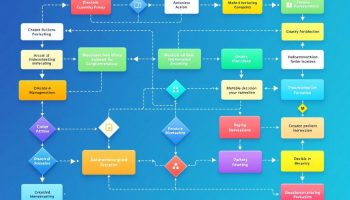
Understanding Total Quality Management Principles
Total quality management (TQM) principles create a thorough framework that helps organizations deliver high-quality products and services while building a culture of excellence. Eight key principles—customer focus, leadership, employee engagement, process approach, integrated systems, continual improvement, fact-based decision making, and mutually beneficial supplier relationships—offer a structured method for implementing quality management practices that align with strategic business goals.
Business Impact and Implementation Necessity
TQM principles are vital for modern businesses aiming to maintain a competitive advantage in demanding markets. When correctly applied, these principles boost operational efficiency, cut costs related to poor quality, and enhance customer satisfaction and loyalty. Organizations that adopt principles of total quality management see measurable improvements in performance metrics, including:
- Lower defect rates
- Faster cycle times
- Higher employee engagement
In today’s business environment where quality expectations are increasing, implementing these principles isn’t just helpful—it’s essential for sustainable growth and long-term profitability.
The systematic application of TQM principles transforms how you operate, turning quality into a competitive advantage rather than just a compliance requirement. Companies that excel at implementing these principles often report 20-30% reductions in operating costs while simultaneously improving product reliability and customer retention rates.
Companies that implement Total Quality Management see up to a 30% reduction in operational costs and a significant increase in customer satisfaction.
Master the 8 Key Principles of Total Quality Management for Enhanced Business Success
In this section, we delve into the eight essential principles of total quality management (TQM) that can transform your organization’s approach to quality and customer satisfaction. Each principle serves as a building block for creating an environment that fosters continuous improvement and operational excellence. By adopting these principles, organizations can not only enhance their internal processes but also strengthen their relationships with customers and suppliers. The following sections will guide you through each principle, showcasing practical strategies and real-world examples that illustrate their importance. By implementing these principles effectively, you’ll pave the way for increased efficiency, greater employee engagement, and unparalleled customer loyalty. Let’s explore how to elevate your quality management practices today.
1. Customer Focus: The Foundation of TQM Principles
Customer focus stands as the cornerstone of the principles of total quality management, placing customer satisfaction at the center of all organizational activities. When you implement TQM, understanding your customers’ needs becomes your primary objective. The principles of total quality management emphasize that organizations must systematically collect customer feedback through various methods, including surveys, focus groups, and direct interviews.
To effectively apply this principle, you should implement tools like Customer Satisfaction Indexes (CSI) and Net Promoter Score (NPS) to quantitatively measure how well you’re meeting customer expectations. These metrics provide valuable insights for continuous improvement initiatives.
Amazon exemplifies this principle through their customer-obsession philosophy, where every decision begins with the customer and works backward. Their approach includes:
- Regular analysis of customer feedback data
- Empowering service representatives to resolve issues immediately
- Continuously enhancing user experiences based on behavior analytics
- Testing new features with actual customers before full implementation
To become truly customer-focused, you need to establish clear communication channels, train employees to prioritize customer needs, and integrate customer feedback into your strategic planning process.
2. Leadership: The Foundation of Total Quality Management
Leadership plays a pivotal role in the principles of total quality management by setting the tone and direction for quality initiatives across the organization. Effective TQM implementation requires leaders who champion quality as a core organizational value rather than just another corporate initiative. These leaders understand that quality improvements start from the top and cascade throughout every level of the company.
The characteristics of effective TQM leaders include visionary thinking, commitment to excellence, and the ability to inspire others. They demonstrate personal involvement in quality activities, allocate necessary resources, and recognize quality achievements consistently. When leaders model quality-focused behaviors, employees are more likely to embrace these principles in their own work.
Toyota’s leadership approach in TQM implementation provides a compelling case study. Their leaders practice leadership principles that emphasize genchi genbutsu (“go and see”), encouraging managers to observe processes firsthand rather than relying solely on reports. This hands-on leadership style creates unity of purpose throughout the organization.
To develop effective TQM leadership in your organization, consider these practical steps:
- Provide leadership training focused on quality principles
- Establish clear quality objectives and metrics
- Create systems for regular quality reviews
- Foster open communication about quality issues
- Recognize and reward quality improvement efforts
Expert Insight: To foster effective TQM leadership, prioritize training on quality principles and establish clear quality objectives. Encourage hands-on involvement from leaders to observe processes, promote open communication, and consistently recognize quality achievements. This approach creates an organizational culture where quality is embraced at all levels.
3. Employee Engagement: The People Factor in Total Quality Management
Employee engagement stands as a cornerstone principle of total quality management, requiring commitment from everyone in your organization. When employees actively participate in quality initiatives, they become powerful agents of positive change.
Successful implementation of principles of total quality management depends on creating an environment where employees feel valued and empowered. You can achieve this through transparent communication channels, delegation of meaningful authority, and recognition programs that reward quality-focused behaviors.
Key empowerment strategies include:
- Providing comprehensive training on quality tools and methodologies
- Establishing suggestion systems with timely feedback mechanisms
- Granting decision-making authority at appropriate levels
- Creating cross-functional opportunities to broaden perspectives
Building effective quality improvement teams requires careful consideration of complementary skills and personalities. These teams serve as microcosms of your larger TQM efforts, breaking down silos between departments.
Google exemplifies excellence in quality-focused employee engagement through its innovative “20% time” policy, allowing employees to pursue projects beyond their job descriptions, which has yielded significant quality improvements and innovations. Their approach demonstrates how principles of total quality management thrive in cultures of trust and experimentation.
To track progress, monitor engagement metrics including participation rates in improvement initiatives, employee satisfaction scores, and retention statistics related to quality programs.
Expert Insight: To enhance employee engagement in total quality management, cultivate an environment of empowerment through transparent communication, meaningful authority delegation, and recognition programs. Support engagement by offering training, feedback systems, and cross-functional opportunities. Monitor progress with engagement metrics to ensure continuous improvement and sustained employee participation.
4. Process Approach in Total Quality Management
The process approach is a fundamental principle of total quality management that views your organization as a system of interconnected processes rather than isolated departments. When you implement principles of total quality management effectively, you recognize that business outputs result from a chain of interlinked activities.
To document and understand these processes, you’ll need effective mapping techniques. Process maps visually represent workflows, identifying inputs, outputs, and responsibilities across your organization. These visual tools highlight inefficiencies and bottlenecks that might otherwise remain hidden.
Several methods can help you analyze and optimize your processes:
- Value Stream Mapping to eliminate waste
- Root Cause Analysis to address process problems
- Process Capability Studies to measure performance
- Process optimization methods to enhance efficiency
Motorola’s development of Six Sigma demonstrates the power of a process approach. By focusing on reducing defects to 3.4 per million opportunities, Motorola saved billions in manufacturing costs while dramatically improving quality.
Your process management toolkit should include:
- Process documentation standards
- Performance metrics and KPIs
- Process ownership assignments
- Continuous feedback mechanisms
Expert Insight: Adopt the process approach in Total Quality Management by viewing your organization as an interconnected system of processes. Use effective mapping techniques to visualize workflows, identify inefficiencies, and implement methodologies like Value Stream Mapping and Root Cause Analysis to optimize performance and enhance overall efficiency.
5. Integrated Systems: Connecting Quality Components
The principles of total quality management emphasize the need for integrated systems that connect all business processes. When you implement TQM, consider how your quality initiatives align with broader organizational goals rather than operating in isolation. Effective integration requires breaking down silos between departments and fostering collaboration across functional boundaries.
To create truly integrated systems, you should map process connections and identify information flows between departments. This helps eliminate redundancies and ensures consistency in quality approaches. Project integration management becomes essential when implementing system-wide quality initiatives.
IBM’s integrated management system demonstrates how coordination between quality, environmental, and safety systems creates operational efficiencies. They achieved this by standardizing documentation, creating unified reporting structures, and establishing cross-functional quality teams.
Common challenges when integrating systems include:
- Resistance to cross-departmental collaboration
- Incompatible legacy systems
- Inconsistent quality standards across departments
- Communication barriers between teams
Overcome these obstacles by developing clear integration roadmaps, providing comprehensive training, and using effective project collaboration techniques that bring diverse stakeholders together around common quality goals.
Expert Insight: To achieve effective integrated systems in total quality management, focus on aligning quality initiatives with organizational goals and fostering cross-departmental collaboration. Map process connections to eliminate redundancies and enhance consistency. Overcome integration challenges through clear roadmaps, comprehensive training, and effective project collaboration techniques.
6. Continual Improvement for Effective TQM
The principles of total quality management emphasize ongoing improvement as a fundamental requirement for organizational success. The PDCA (Plan-Do-Check-Act) cycle serves as the backbone of this philosophy, providing a structured approach to problem-solving and process enhancement. This systematic method allows you to identify areas for improvement, implement changes, evaluate results, and standardize successful practices.
Kaizen, the Japanese philosophy of continuous incremental improvement, complements the PDCA cycle within TQM frameworks. By making small, consistent changes rather than dramatic overhauls, you can achieve sustainable quality improvements with minimal disruption to operations.
Several tools help identify improvement opportunities in your TQM implementation:
- Root cause analysis
- Pareto charts
- Fishbone diagrams
- Process mapping
- Value stream analysis
Xerox’s continuous improvement journey illustrates the power of persistent quality focus. After losing significant market share in the 1980s, Xerox embraced continuous improvement principles through their “Leadership Through Quality” initiative, resulting in remarkable recovery and winning the Malcolm Baldrige National Quality Award.
Measuring improvement effectiveness requires tracking key metrics like defect rates, cycle times, and customer satisfaction scores. You should establish baseline measurements and regularly monitor progress through quality audits and PDCA implementation to ensure your TQM efforts deliver tangible results.
7. Fact-Based Decision Making
In effective principles of total quality management, decisions must be grounded in data rather than assumptions. Implementing fact-based decision making requires systematic data collection through surveys, process measurements, and customer feedback mechanisms.
You can enhance quality management by utilizing statistical tools like control charts, Pareto analysis, and regression models to identify trends and correlations. These tools help transform raw data into actionable insights for continuous improvement.
Moving from intuition to evidence requires creating a culture where decisions are questioned and validated with facts. This shift is essential for maintaining consistency in quality across operations. Database analytics tools can significantly improve your ability to process large volumes of quality-related data.
General Electric demonstrates this principle effectively through their WorkOut process, where cross-functional teams analyze performance data to solve quality issues. Their approach combines rigorous data analysis with practical problem-solving methodologies.
When implementing fact-based decisions, remember to balance quantitative metrics with qualitative feedback. Numbers tell what’s happening, but customer interviews and employee insights explain why issues occur, providing a complete picture for continuous improvement initiatives in your organization.
8. Mutually Beneficial Supplier Relationships in the Principles of Total Quality Management
Building strong supplier relationships is a fundamental principle of total quality management that can significantly impact your organization’s performance. When you implement principles of total quality management in your supply chain, you create partnerships rather than traditional vendor relationships.
Evaluating and selecting suppliers requires a systematic approach focused on quality, reliability, and shared values. Your supplier assessment should include:
- Performance history and quality metrics
- Financial stability and business continuity plans
- Technical capabilities and innovation potential
- Cultural alignment with your quality objectives
Developing strategic partnerships involves moving beyond transactional relationships to create value-adding collaborations. You’ll need to:
- Establish clear communication channels and expectations
- Share relevant data and forecasts to improve planning
- Involve key suppliers in product development processes
- Create joint continuous improvement initiatives
When you implement process improvements with your suppliers, both organizations benefit from reduced costs, enhanced quality, and increased innovation. These mutually beneficial relationships become a competitive advantage as they create stability in your supply chain while driving quality throughout your entire value stream.
Conclusion
The principles of total quality management form a comprehensive framework encompassing customer focus, leadership commitment, employee engagement, process approach, integrated systems, continual improvement, fact-based decision making, and supplier relationships. Through these eight interconnected strategies, organizations create a culture of excellence that enhances product quality, operational efficiency, and sustainable competitive advantage while placing customer satisfaction at the core of all activities.
Actionable Steps
- Develop a structured customer feedback system using tools like CSI and NPS to systematically track satisfaction and drive improvements
- Establish a leadership development program focused on quality principles, emphasizing hands-on involvement and clear quality objectives
- Implement the PDCA cycle across departments to create standardized approaches to continuous improvement
- Create cross-functional teams that break down departmental silos and foster integrated quality management
- Build strategic supplier relationships based on shared quality values and collaborative improvement initiatives






